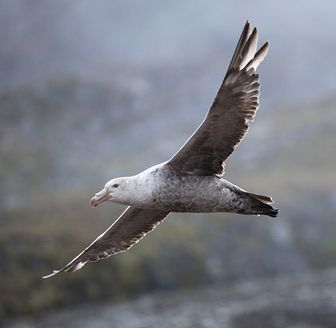Northern Giant-Petrel
The Northern Giant Petrel along with its counterpart, the Southern Giant Petrel, make up the Macronectes genus. They come from the Procellariiformes order, which are referred to as tube-nosed seabirds, due to their unique nose structure. All Tube-noses have tubular nostrils, and all Procellariidae have the openings on top of the upper portion of the bill. Procellariiformes also have between seven and nine distinct horny plates for their bill, and Petrels have one of these plates that form the hooked portion of their upper bill called their maxillary unguis. They produce a stomach oil made up of wax esters and triglycerides that is stored in the proventriculus. This is used against predators as well as an energy rich food source for chicks and for the adults during their long flights.

Original source: Northern Giant Petrel flying over Godthul, South GeorgiaUploaded by Snowmanradio
Author: Liam Quinn from CanadaCamera location
The Northern Giant-Petrel is classified as Least Concern. Does not qualify for a more at risk category. Widespread and abundant taxa are included in this category.
The Northern Giant-petrel Macronectes halli, is a large seabird of length 80-95cm and wingspan 150-210cm. The species is sexually dimorphic, with males markedly larger and heavier-billed than females (Marchant and Higgins 1990). A single colour morph exists, comprising white about the bill and face, a dark grey-brown body, and mottling at the borders. The species is listed as Vulnerable under the Commonwealth Environment Protection and Biodiversity Conservation Act 1999. 2. More
Northern giant-petrel - Scientific Committee determination Northern Giant-Petrel - profile = Scientific name: Macronectes halli Conservation status in NSW: Vulnerable National conservation status: Vulnerable Description - A large seabird up to 95cm in length with a wingspan of 150-210cm. The species is sexually dimorphic, with males markedly larger and heavier-billed than females. More

Original source: Arthur Chapman
Author: Arthur Chapman
Permission: Some rights reserved
Family : Procellariidae
Genus : Macronectes
Species : halli
Authority : Mathews, 1912
